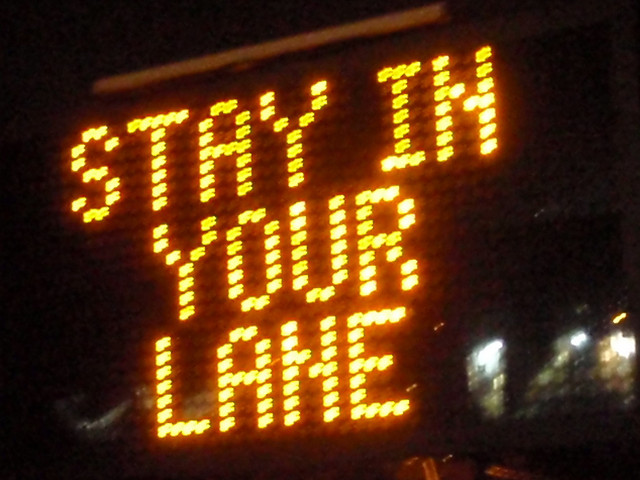
If you have a driver’s license you may vaguely remember “Failure to Maintain Lane (FTML)” traffic violation from driver’s education. It is one of the most common violations that causes accidents. It can lead to drifting into oncoming traffic or swerving to avoid an accident. and causing an accident. If a driver change lanes, the rules of the road require the driver wait until it is safe to do so and signal to alert other drivers.
What does FTML have to do with local government?
When I say lane, I’m thinking about the departmental organization chart. I am a planner and am labeled in the planning department, not fire, police, or public works. Organization is helpful, but our challenges don’t use our organizational chart. I cannot plan a bike friendly community without the traffic engineer’s cooperation. The traffic engineer may need the planner’s community engagement expertise to communicate a neighborhood road closure. This applies to most challenges we face in local government. If we stayed in our lane all of the time we would hit a dead end.
I have been accused of straying out of my local government lane on many occasions. If I’m honest, the accusers were usually right. However, my most valuable learning moments occurred working outside of my lane.
I have realized that organizations are made of up of people who stay in their lanes, and people who don’t. To manage an organization, especially a large one, people generally need to stay in their lane. If everyone left their lane all the time, the organization would be entirely chaotic. But I think to innovate or transform, lane changing and creative maneuvering is required.
The challenge we face is choosing when to switch lanes, and when to stay in our lane Sometimes we run into challenges that require getting out of our lane. Ideally we are invited to change lanes, but sometimes we have to force a merge. A recent example of this occurred at my prior city. We were struggling to grasp what future road maintenance would look like for the city. How much would it cost? How many miles of road needed paving? Could other methods be applied to preserve payment?
I asked the public works director if I could use the pavement condition report data to create a plan. He signaled he was open to letting me into his lane to help. We used the data to create a ranking system that placed the streets into categories. Based on those categories we predicted which streets would need paving the soonest, which streets could have a preservation treatment, and how the scenario would look financially.
We created a model that looked at the paving life cycle and could be manipulated based on how much the city could invest. The maps and charts of the road conditions were revealing and lead to a discussion on road maintenance funding. We now had a measurement, a cost, and a plan, even if it was yet to be funded.
In this case, getting out of my lane was worthwhile. It was welcome and mission driven. Had I decided I could write the shift schedules of the fire department better than the fire department leadership my lane change may not have been as welcome.
So how to you know when to jump out and change lanes?
- Know your job first. It is best to maintain the lane until you have your lane covered.
- Choose the right moment. Every opportunity that comes along to insert your opinion, skills, and efforts into other parts of local government may not be worthwhile. Checking the temperature of those involved and your supervisor is important. Sometimes the risk is worth it, other times it may very well be best to let the moment pass (I struggle to do this, and have experienced great highs and lows as a result).
- Respect legal and ethical responsibilities. Certain duties are legally assigned to departments and positions. Honoring those is important. Bringing your skills to a problem the police chief is facing may be helpful, but only if the organizational authority is respected.
- Have perspective. If you are venturing out of your lane make sure you have perspective of the challenge from multiple vantage points. What looks simple from the outside is always more complex.
- Build a strong data based argument. A strong data based argument is important, but if you are jumping out of the ranks to tackle a bigger problem, strong data is a great shield.
- Know the end destination. Is the lane change inline with the long term vision for the community? If it is not, it is probably not worth it.
I want people on my team that know when lane changing is worthwhile. I want people on my team who stay in their lane to maintain balance.
My time spent in other lanes has equipped me to understand my role in the larger network. I have been lucky to work with people who embraced letting me into their lanes. Building cross departmental relationships is a type of lane changing that is valuable, and fairly risk averse. Those that tend to do well solving local government problems, generally have extended their circle through learning how to change lanes well.
What I’m Reading: The New Jim Crow by Michelle Alexander
What I’m Listening to: Jack White in preparation for seeing him live in concert in September.
What I’m Re-Watching: The Wire
